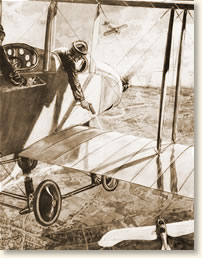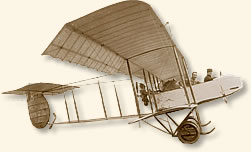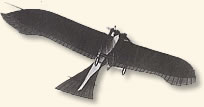|
The Beginning of
Air Warfare, 1914
 |
| Illustrated London News |
Aerial Warfare,1914
British observers fire on a German
Taube reconnaissance plane |
As the combatants clashed in the opening days of
World War I, the newly invented airplane provided each side with a "bird's eye
view" of the battlefield. The value of this new reconnaissance tool was proven
at the first major engagement of the war - the Battle of Mons on August 23, 1914.
It was at Mons, a small industrial town in southern Belgium, where the advancing
British Army collided with the Germans as they marched towards France.
From their vantage point above the battleground, a British observation team
could see that the Germans were moving their forces to surround the unsuspecting British
army. Alerted, the British high command ordered an immediate retreat into
France. As embarrassing as the withdrawal was for the British, the move saved
the army. A few days later, French aerial observers noted a shift in the movement
of the German army that exposed its flanks to attack. The resulting battle
of the Marne (September 5 - 12), halted the German drive into France and saved
Paris.
The airplane's value as an observation platform had been proven. This revelation
led to the next developmental step in air warfare - the effort to blind the
enemy by shooting down its eyes in the sky. It would be months before a French
pilot would strap a machinegun to the nose of his airplane to create the first
true fighter plane (see The Birth of the Fighter Plane, 1915). In the interim, warfare in the air was characterized by
the occupants of enemy observation planes firing at one another with pistols,
rifles or, as the following account describes, throwing an unloaded revolver
at an opponent's spinning propeller.
Lt. W. R. Read was a pilot in the fledgling Royal Flying Corps. In the early
days of August 1914 the Corps was ordered to transport its force of 63 planes
to France and provide reconnaissance of enemy troop movements. Read kept a
diary of his experiences and we join his story as he and his observer - Jackson
- fly over the area of Mons, Belgium. Throughout his narrative, Lt. Read refers
to his plane as "Henri:"
"One day, after our reconnaissance over Mons and
Charleroi, Jackson
spotted a German Taube machine.
I had also seen him but we had done our job and I did not want a fight. Jackson
was always bloodthirsty, however, and the following shouted conversation
ensued:
Jackson: 'Look, old boy!'
'Me: 'Yes, I know.’
'Jackson: ‘I think we ought to go for him,
old boy.’
Me: 'Better get home with your report.'
Jackson: 'I think we ought to go for him,
old boy.'
Me: 'All right.' "
 |
A Henri Farmen observation plane
similar to that flown by Lt. Read
He called his "Henri"
|
I changed course for him and, as we passed the Taube,
Jackson got in two shots with the rifle. We turned and passed each other
again with no obvious result. This happened three or four times. Then, ‘Have
you got a revolver, old boy? My ammunition's all gone.’ I, feeling
rather sick of the proceedings, said ‘Yes. But no ammo.’ ‘Give
it to me, old boy, and this time fly past him as close as you can.’ I
carried out instructions and, to my amazement, as soon as we got opposite
the Taube, Jackson, with my Army issue revolver grasped by the barrel,
threw it at the Taube's propeller. Of course it missed and then, honor
satisfied, we turned for home.
22 August. Today the French distinguished themselves by bringing
down one of their own airships. They also often fire at us and there is quite
as much to fear from one's own side as from the Germans as one leaves the
ground. Two machines that went out this morning on reconnaissance came back
with several bullet holes in them. In one the observer was shot in the stomach.
Herbert, Shekleton, Fuller and I are the 4 pilots in our Flight. We do more
flying than most other flights probably because Henri is a more reliable
machine and is always ready. Shek. came back last night with six shot holes
in his planes. One bullet missed the petrol tank only by an inch.
23 August. Went up for reconnaissance at
11.30 with Major Moss as passenger [observer]. I could not get Henri to
climb at first so came down and lightened the load, then we soon got away
at 3,800 feet. We found the enemy very thick to the south-east of Thuin
and a battle was in progress below us. The artillery on both sides were
very busy. It was very interesting
to watch. In one field a French battery opened fire; it had not fired more
than two rounds per gun when shell after shell from a German battery burst
over them. It must have been perfect hell for the French battery and silenced
them at once. On the way back some German howitzer battery opened fire on
us from north-west of Thuin. One shell splinter passed through my left plane
but did no damage. Some infantry in Thuin also wasted a thousand rounds or
so trying to bring us down.
'24 August. All yesterday heavy firing to the
east and northeast, and it was apparent that the enemy was pushing us back.
I was sent off on to some high ground to look out for zeppelins!! NO.3 Squadron-ours-left
at 2.30 pm, landed at Berlmont at 6.45 pm, then ordered to retire further
back to Le Cateau. A great rush to get off as it was getting dusk. I and
some others landed in a wrong field but went on to the right one afterwards.
Birch in his Bleriot hit the telegraph wires in getting off and broke his
machine, escaping with a shaking himself.
'25 August. Yesterday the Germans had a
victory at Mons. Today parts of Charleroi are in flames and the enemy are
turning our left flank. I went off at 11 am with Jackson as passenger.
All our troops were in retreat, using every road available and making for
Le Cateau. The whole of the French cavalry were retiring on Cambrai. Returned
from reconnaissance at 1
pm and at 3.30 orders came to move to St Quentin. As soon as we landed a
heavy rain-storm came on and swamped everything. I feel so sorry for poor
Henri. It is doing him a great deal of harm, this rain and hot sun.
 |
A German Taub observation plane
|
'26 August. Off on reconnaisance at 7 am with
Jackson to report on engagements in the Le Cateau and Espignol area. The
whole sight was wonderful - a fierce artillery engagement for the most part,
we getting the worst of it. We had all the German army corps against our
little force. We could see nothing of the French. I watched one of our batteries
put out of action, shell after shell burst on it and then there was silence
until more men were sent up and it opened up again.
'Le Cateau was in flames. We were shelled by anti-aircraft
guns so I kept at 4,500 feet. We are also giving the Germans a bad time-their
cavalry and infantry nearly always advanced in masses, offering as they did
so a splendid target and getting mown down by the score. There was not a
suitable place to land at headquarters at Bertry. In landing we skidded and
as soon as we touched ground the landing chassis gave way and Henri pitched
on his nose. Jackson was pitched out about ten yards ahead and I was left
in the machine. Neither of us was hurt only shaken. Good old Henri, he did
me well and even at the last he did not do me in. There was no time to repair
the damage as shells were already falling over the town so I hurriedly removed
all the instruments, guns, maps etc. and cut off the Union Jack and so left
Henri in his last resting place."
References:
This eyewitness account appears in: Moynihan, Michael, People at War 1914-1918 (1973); Boyne, Walter J., The Smithsonian Book of Flight (1987); Reynolds, Quentin, They Fought for the Sky (1957); Simkins, Peter, World War I: the western front (1991).
How To Cite This Article:
"The Beginning of Air Warfare, 1914," EyeWitness to History, www.eyewitnesstohistory.com
(2008).
|






